What to do when the range hood drips water on the stove?
In winter, moisture problems caused by condensation also increase in the kitchen. What is it about when the range hood "drips water" or its electronics get wet and the switches or the motor stop working. In both cases, the problem is not caused by the range hood, but rather by moisture (condensation) condensing in the flue.
The problem is, especially in cold weather, condensation of moisture in the flue and water draining into the range hood and thereby onto the tabletop. Often water that has flowed into the motor also causes the cooker hood to break. The range hood does not tolerate water running into it!
Below is information on the matter and a few tips if the range hood starts dripping water onto the stove.
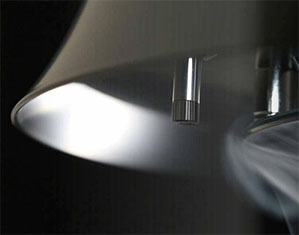 |
WHY DOES CONDENSATION FORM?
Air consists of a mixture of different gases and always contains some water vapor. At a high temperature, the amount of water vapor is greater than at a low temperature. When water vapor meets a cold surface, it condenses into water. Condensed water is water condensed from air due to temperature change.
Water condenses in the flue when the stove fan blows warm and moist indoor air out of the house into the colder outdoor air through the flue pipe. Warm air can bind a considerable amount of moisture. When the blown-out air cools, its ability to absorb moisture deteriorates and the moist air begins to condense into droplets.
Another factor that causes condensation problems is the imbalance of ventilation pressure. The building regulations specify that the ventilation of the house must be under negative pressure. When the house is put into use, its ventilation is adjusted correctly by the air conditioning contractor. If the house's ventilation is not under negative pressure, the house's excess pressure is released through the hood's flue, opening the non-return valve in the flue and warm, moist air begins to flow slowly into the flue pipe. In this case, moisture condenses on the surfaces of the flue pipe, causing a condensation problem.
In particular, condensation occurs under the influence of rapid changes in weather conditions. Cold spaces or uninsulated pipes are particularly prone to condensation.
|
|
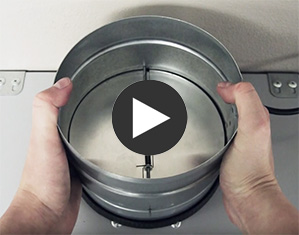 |
RETURN VALVE AND WHY IT IS AN IMPORTANT PART OF A COOKER HOOD
If the kitchen hood has its own exhaust duct, the non-return valve is a nexessary part of the hood. The non-return valve has opening/closing flaps that reduce the flow of cold air back in to the room.
The flue check valve must be installed and its correct opening and closing must be tested during installation. A malfunctioning non-return valve can be recognized, for example, by cold air flowing over the hob.
Check valves are available for flues of different sizes and you can order them on the Lapetek website under accessories.
See the operation of the check valve in the video.
|
|
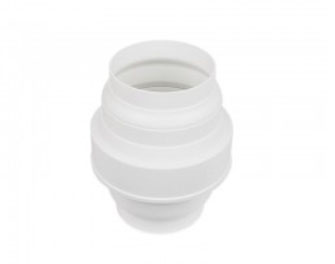 |
A CONDENSATE WATER COLLECTOR IMPROVES THE SITUATION
With the help of a condensate collector, water that condenses in the flue is reduced from flowing into the cooker hood and through it further to the hob. Condensed water remains inside the collector and is slowly removed from it thanks to the air flowing through it when the fan is on.
The collector works best as a collector of small amounts of water, preventing condensed moisture in the flue from draining as water into the electric parts of the range hood.
The collector reduces the condensation water draining into the stove hood, but does not eliminate the actual condensation problem. The collector also cannot hold large amounts of water, so it is particularly important that the structures are repaired in such a way that condensation problems do not arise.
The condensate collector is suitable for 125 mm and 160 mm pipes.
Read more about the condensate collector here >
|
|
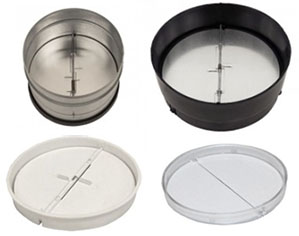 |
HOW DO THE EXHAUST PIPE AND ITS INSULATION AFFECT THIS?
The warm and moist indoor air blown out starts to condense into droplets when the air has cooled down enough or it meets cold surfaces, e.g. a cold flue pipe. For this reason, the flue pipe must be adequately insulated along its entire length.
The exhaust pipe must be insulated the entire way when it travels in a "cold" space outside the house insulation with sufficient thermal insulation suitable for the purpose. The flue pipe and possible extension joints must be intact and completely sealed from the warm space all the way to the outside flue outlet.
Exhaust duct leakage and insulation problems cause condensation of moist exhaust air passing along the ducts in the ducts. As a result, the water running down the chimneys can cause the hood to break, as well as moisture damage to the building.
|
|
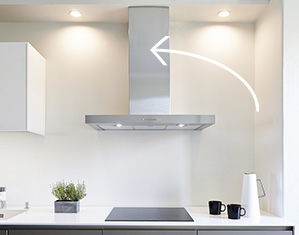 |
HOW DOES THE PRESSURE IN THE HE HOUSE AFFECT IT?
The ventilation of the house must be adjusted correctly and in such a way that the building is under pressure compared to the outside air, as required by D2 Finland's building code collection. The building must not be overpressured, but not too underpressured either.
If the house's ventilation is overpressured, the house's overpressure is released out of the house through the hood's flue. The pressure cracks the non-return valve in the flue and the warm, moist air in the apartment begins to flow slowly into the flue pipe. After this, moisture condenses on the surfaces of the flue pipe, causing the hood to break and, in the worst case, moisture damage to the building.
Ventilation adjustment can only be carried out by a company qualified for ventilation adjustment. Usually, the adjustment is made by the air conditioning contractor before the house is put into use and, if necessary, also later again.
In an improperly pressurized house, even properly insulating the flue does not eliminate the condensation problem.
|
|
BE SURE TO CHECK THESE POINTS:
- the extractor hood exhaust pipe must be insulated
- the seams must be tight along the entire length of the flue
- the correct size non-return valve must be installed tightly in the flue
- the correct opening direction of the non-return valve must be checked
- the ventilation of the house must be under pressure
You can also find additional instructions here >
|
|





